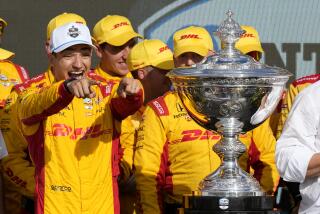NASCAR Says Belt a Factor
- Share via
ATLANTA — Six months, 54 experts and $1 million later, there are no definitive answers to all the questions about stock car driver Dale Earnhardt’s fatal crash.
Still, NASCAR, the body that sanctions and runs Winston Cup racing, keeps coming back to the broken seat belt.
NASCAR’s investigation determined Tuesday that a broken seat belt was a factor in Earnhardt’s fatal wreck on the last lap of the Daytona 500 on Feb. 18, but its report does not recommend widespread changes to improve safety.
The seat belt, the collision with another car and the angle and impact at which Earnhardt’s car hit the wall all played a role in his fatal basilar skull fracture, the report said.
In its two-volume report, NASCAR said that beginning next season, it will install “black boxes” in cars--similar to flight-data recorders on airplanes--to help understand the forces during crashes and improve safety.
However, NASCAR won’t require drivers to wear head-and-neck restraints, although it said it encourages their use.
“We are still not going to react for the sake of reacting,” NASCAR President Mike Helton said.
Earnhardt was not wearing a HANS restraint when he was killed, but NASCAR said it was unclear whether the device would have saved him. Use of the device has dramatically increased since his crash. In Sunday’s race at Michigan International Speedway in Brooklyn, Mich., 41 of 43 drivers wore them.
Helton said NASCAR will use computer models to design safer cars and will test racetrack barriers. However, the report contained no recommendations on changes to cars or barriers.
“There’s not a bulletin getting ready to go out this afternoon to change walls at racetracks or roll bars in race cars,” Helton said. “But there was an effort that began this time last year, and that became very aggressive as we were given opportunities in a very tragic way to understand things that we never understood before.”
Five days after Earnhardt’s death, NASCAR held a news conference in Rockingham, N.C., and revealed it had discovered the broken left lap belt the morning after the race.
On Tuesday, Dr. James Raddin, one of the lead investigators, said the conclusion of the report is that “there were a number of factors in which the timing came together” to cause Earnhardt’s death.
Raddin said one finding was that the belt broke from the force of slamming into the concrete wall at about 160 mph, allowing the driver to be flung farther forward and to the right than if the entire five-point seat-belt harness had remained intact.
He added that the study found the collision with the car driven by Ken Schrader before both slammed into the wall might have played a major role in the death of the seven-time Winston Cup champion.
Earnhardt was thrown to the right, and his fatal injuries apparently occurred when his head turned, his helmet rotated on his head and the left rear of his skull was left bare to hit the side of the steering wheel, the rear of the seat or both, the report said.
In finding that the fracture started with a blow to the back of the head, Raddin disagreed with a court-appointed, independent medical examiner who determined the fracture was caused by a violent head whip. That examiner, Barry Myers of Duke University, studied Earnhardt’s autopsy photos and concluded earlier this year that seat-belt failure “does not appear to have played a role” in his death.
Raddin did not have access to the autopsy photos, however, and Myers said Tuesday that he remained convinced “that my report and conclusions are correct.”
John Melvin, an independent safety expert who has worked with NASCAR on several projects, said an interesting part of the report concerned the finding about the impact of Schrader’s car.
“It threw Dale Earnhardt to the right and left him vulnerable when he came back to the left,” Melvin said. “A net or a better seat or a better safety harness or a HANS--all the things we’ve been talking about--could have made a difference. But you need the total package.”
Richard Childress, Earnhardt’s longtime car owner, hoped the NASCAR report “can bring some closure.”
“It is now time to move on,” he said. “This has been a very painful process for a lot of us.”
Helton said his organization will commission a study on restraint systems to take a closer look at seat-belt strength. NASCAR also is working on opening a research center in Conover, N.C., sometime next year and will continue to work with experts, including Raddin and Melvin, on car safety.
But NASCAR still will not mandate the use of the head-and-neck restraints that are designed to reduce violent head whips in crashes.
“We are pleased that a majority of Winston Cup drivers now use them,” Helton said. “But we are not completely satisfied. We have intensified our efforts with drivers, equipment manufacturers and outside experts with the goal of helping all drivers find a system in which they feel comfortable and safer.”
As for the seat belt, Raddin said it was not cut by rescue workers as they tried to remove Earnhardt from the battered car.
“The physical evidence is clear,” he said, displaying a blown-up photo of Earnhardt’s seat belt. “This was not a cutting of a belt afterward. This was a belt that separated under load.”
Raddin, a director with Biodynamic Research Corp. of San Antonio, attributed the break to a phenomenon called “dumping,” which occurs when the webbing is pulled or moved to one side of the adjustment device.
When a dumped belt is under stress, it can separate and tear across the entire webbing.
Raddin concluded that the dumping was not caused by driver adjustment because the marks on the left lap belt showed it was tightened in a symmetrical fashion.
The controversy over the seat belt, made by Simpson Performance Products, led to the resignation of the founder of the company. Bill Simpson quit last month, saying the stress “got to be too much.”
In mandating the installation of “black boxes,” which will only record data, NASCAR is following the example of the U.S. organizations sanctioning open-wheel racing, CART and the Indy Racing League.
General Motors and Ford have been supplying black-box technology to those groups for several years in an effort to better understand the forces in crashes. Until now, NASCAR had resisted using the boxes, in part because it feared teams would use the information for competitive advantages.
“You hear all the time about what the FAA does after a plane goes down somewhere,” driver Jeremy Mayfield said. “The objective is to not just find out what happened, but to come up with ways to keep that same thing from happening again.”
The investigation was the most far-reaching independent inquiry in NASCAR’s 52-year history.
Helton, Raddin and a second investigator, Dr. Dean Sicking of the University of Nebraska, met with many of the drivers at a North Carolina country club Tuesday morning to present their findings. Earnhardt’s eldest son, Kerry, and his daughter, Kelly, attended.
Driver Dale Earnhardt Jr. did not attend the presentation, but a NASCAR spokesman said Helton has privately gone over the report with him.
(BEGIN TEXT OF INFOBOX / INFOGRAPHIC)
REPORT HIGHLIGHTS
Key points from NASCAR’s six-month study into the Feb. 18 fatal crash of Dale Earnhardt at the Daytona 500:
Cause of death: A broken seat belt, the collision with Ken Schrader’s car and smashing into the outside wall at 157-160 mph all contributed to Earnhardt’s death from basilar skull fracture.
Steps NASCAR is taking: * Next season, it will install “black boxes” in cars to help understand the impact of crashes and improve safety.
* Computer models to design safer cars will now be used.
* A full-time medical liaison will come on board in 2002.
More to Read
Go beyond the scoreboard
Get the latest on L.A.'s teams in the daily Sports Report newsletter.
You may occasionally receive promotional content from the Los Angeles Times.










